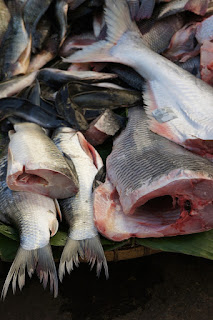When we first began our
tilapia farm, we were told about how to maximize our revenue by using
three levels. The young man who told us was studying fish farming at
the university in Fortaleza. What was suggested for non-commercial
tilapia farmers was to have ducks, tilapia and shrimp. The theory
behind this is all the space was being used.
The ducks obviously on
the surface, eating the vegetation in and around the lake and then
defecating in the water which increased the algae for the tilapia.
The tilapia then poop
and the shrimp eat that. All of that natural fertilzer keeps the
vegetation growing and so the cycle continues.
This, in my opinion is
a good system as you can get paid 3 times for that body of water.
However, there was one
problem we found with this system. It was the ducks.
Now don't get me wrong
I love ducks. I love watching them swim, I love the eggs, I love
eating duck but... they would eat our tilapia food. At first it was
amusing to watch them swim over waiting for us to feed the tilapia.
By the end though, it
was evident that we had to do something about the problem, so we sold
the ducks.
That left us with the
surface of the water not earning us money. That is until we thought
about aquaponics. The revelation came to us with how well our water
hyacinths were growing on our lake we had fish in. Our other lakes
(without fish) also had some hyacinths but the plants weren't growing
very well. That was when the light bulb went on.
It all that goodness in
the water which was feeding the plants.
Not only would we have
enough for ourselves but we would have enough to sell.
My husband and I tend
to be a little cautious and we thought for awhile whether it was
doable. We didn't want anything which was too labor intensive as we
already had enough work with the farm and the fish.
It wasn't until I
returned home from the supermarket with a scrawny looking head of
lettuce, which I had paid R$2.00 (Brazilian reals). When he saw this
and knew what we could produce with aquaponics, we began straight
away.
My only regret with the
aquaponics system is that we didn't start sooner. Not only would we
have been making more money sooner but it would have taken that worry
about keeping all your eggs in one basket.
I mean tilapia farming
is almost a guaranteed return on investment but there are things
which can go wrong. With aquaponics, that gives us a buffer of cash
just in case the unforeseen should happen.










